This paper deals with the topic of cohabiting fertility and its underlying educational gradient. My aim is to analyse, how cohabiting fertility has developed among women with different educational levels in various European countries and the USA. This topic is of major importance, because over the past decades, starting in the 1970s, there has been a huge increase not just in cohabitation, but also in cohabiting fertility across Europe and the USA.
Nevertheless, differences between countries persisted, displaying only a marginal increase and importance of cohabitation in family formation for some countries. Especially in South European countries like Spain and Italy, but also in Russia and Poland, the share of births within cohabitation remains low. In 2004, births within cohabitation only accounted for 10 percent of all births in Italy and 18 percent in Russia. In contrast Norway and France experienced a huge increase in cohabiting births accounting for over 50 percent of all births in 2004 (Perelli-Harris 2010). But even in these countries, fertility within cohabitation did not spread uniformly, showing a leading role for the Northern communities in Norway (Vitali et al. 2015), indicating that variation in cohabitation even exists within countries.
The main theory explaining the societal diffusion of both, cohabitation and childbearing within cohabitation, is the Second Demographic Transition (SDT). According to the SDT, there is a close connection with the ideational value change, leading to a greater social acceptance of behaviours like unmarried cohabitation, non-marital childbearing and divorce. Consequently, the SDT assumes cohabiting births to be more common among higher educated people, because these are ex-pected to break with old traditions and function as forerunners (Perelli-Harris et al. 2010).
Inhaltsverzeichnis (Table of Contents)
- Introduction
- Theoretical Background
- Development of cohabitation
- Types of cohabitation
- Approaches
- Empirical Results
- Discussion
- Bibliography
Zielsetzung und Themenschwerpunkte (Objectives and Key Themes)
This paper analyzes the relationship between educational levels and cohabiting fertility in various European countries and the USA. The study aims to understand how cohabiting fertility has evolved over time and to identify the factors contributing to the observed differences in cohabiting fertility rates across different educational groups.
- The rise of cohabitation and cohabiting fertility across Europe and the USA in recent decades
- The Second Demographic Transition (SDT) as a theoretical framework for understanding the societal diffusion of cohabitation and childbearing within cohabitation
- The role of educational levels in shaping patterns of cohabiting fertility
- The different types of cohabitation and their implications for family formation and childbearing
- The impact of social and legal changes on the acceptance and prevalence of cohabitation
Zusammenfassung der Kapitel (Chapter Summaries)
- Introduction: This chapter introduces the topic of cohabiting fertility and its connection to education. It highlights the increasing prevalence of cohabitation and cohabiting births, particularly in Northern European countries, and outlines the research objectives and organization of the paper.
- Theoretical Background: This chapter provides a theoretical framework for understanding cohabitation and its relationship to family formation. It discusses the historical development of cohabitation, examines various types of cohabitation, and reviews existing research on the factors contributing to the rise of cohabitation and cohabiting fertility.
- Development of cohabitation: This chapter delves into the historical trends of cohabitation, comparing rates across different European countries and birth cohorts. It examines the factors influencing the increasing prevalence of cohabitation, including changing social norms and legal regulations.
- Types of cohabitation: This chapter presents different ideal types of cohabitation, highlighting the diverse meanings and motivations behind cohabitation. It discusses how these different types relate to family formation and childbearing, emphasizing the role of intentions and societal acceptance.
- Approaches: This chapter focuses on various research approaches used to explain the diffusion of childbearing within cohabitation, particularly in relation to educational differences. It explores different theories and methodologies employed to understand the complex interplay of educational levels, social values, and individual choices in cohabitation and fertility.
- Empirical Results: This chapter presents the findings of studies examining the educational differences in cohabiting fertility across various European countries. The results shed light on the extent to which education impacts the likelihood of having a child within a cohabiting relationship.
Schlüsselwörter (Keywords)
This study focuses on the key concepts of cohabiting fertility, educational gradients, the Second Demographic Transition (SDT), family formation, non-marital childbearing, ideal types of cohabitation, and the impact of social and legal changes on family structures.
- Quote paper
- Annika Frings (Author), 2016, The Development of Cohabiting Fertility and its Underlying Educational Gradient. A Comparative Perspective across Countries, Munich, GRIN Verlag, https://www.grin.com/document/504018



